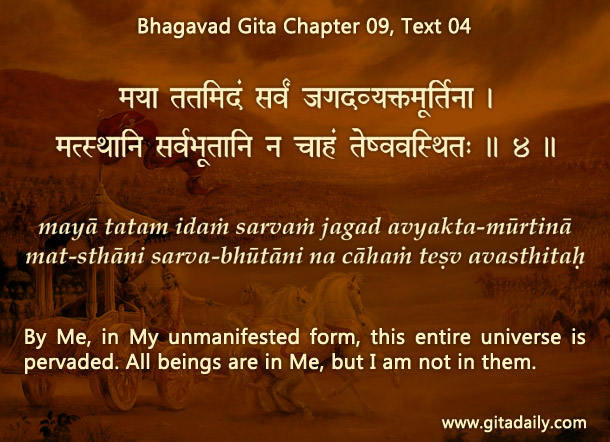The Bhagavad-gita’s ninth chapter makes two seemingly self-contradictory assertions. First, it states (09.04: mat sthani sarva bhutani) that all living beings are situated in Krishna. Then it states (09.05: na ca mat sthani bhutani) just the opposite: living beings are not situated in him.
Intriguingly, the Gita is not oblivious to the self-contradiction; it is aware – and aware not apologetically, but jubilantly. This is evident in the last line of the second verse (09.05: pashya me yogam aishvaram): behold the mystic opulence of Krishna. This celebratory tone stems from the common sense premise that Krishna’s supremacy implies that he is superior to everything, including our intelligence. So, we can’t grasp the workings of that potency by our head alone. Thus, Gita wisdom celebrates Krishna’s inconceivability as an ornament, not a contaminant (bhushana, not dushana). The Gita itself declares later (11.53 – 11.54) that he can be understood only by devotion, wherein we please him with our humble service attitude and he reciprocates by illumining us with revelation.
Being thus illumined, we can realize that the two verses refer to two different divine manifestations that play different roles – the first refers to the immanent Paramatma manifestation that sustains all of material existence; the second, to the transcendent Bhagavan manifestation that has nothing to do with such sustenance.
Thus by devotion we get some understanding of Krishna’s glory. But the essential purpose of knowing him is not comprehension but devotion – greater, deeper, sweeter devotion. This is evident in Arjuna’s response after hearing the four nutshell Gita verses. He indicates that, though no one can comprehend Krishna’s glory fully (10.14), still we can relish it perennially (10.18). The heart attracted to Krishna takes the head along as far as the head can go and then continues further into the inconceivable yet relishable depths of the ocean of devotion.


Leave A Comment